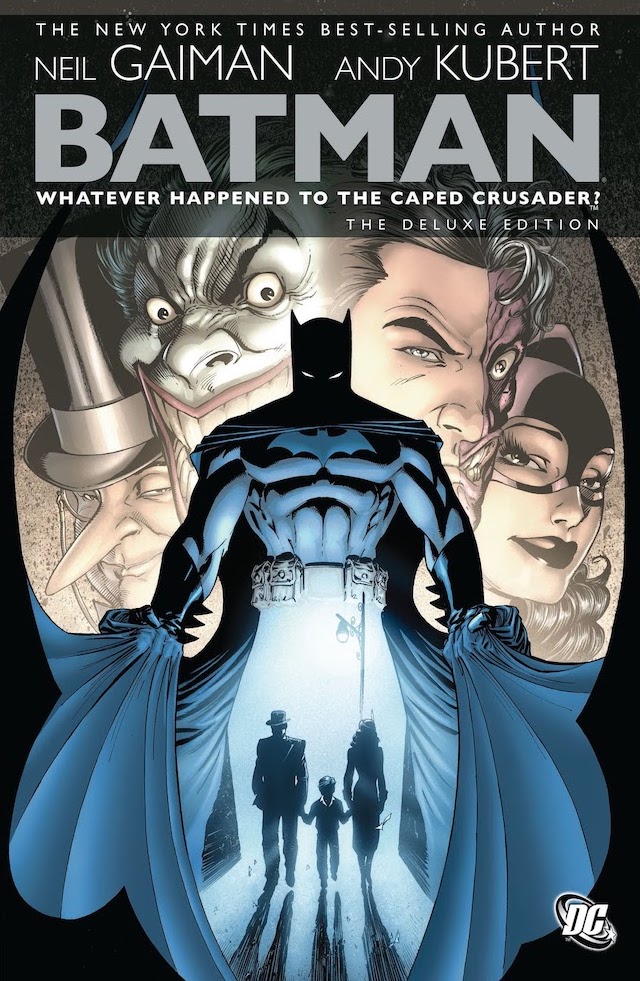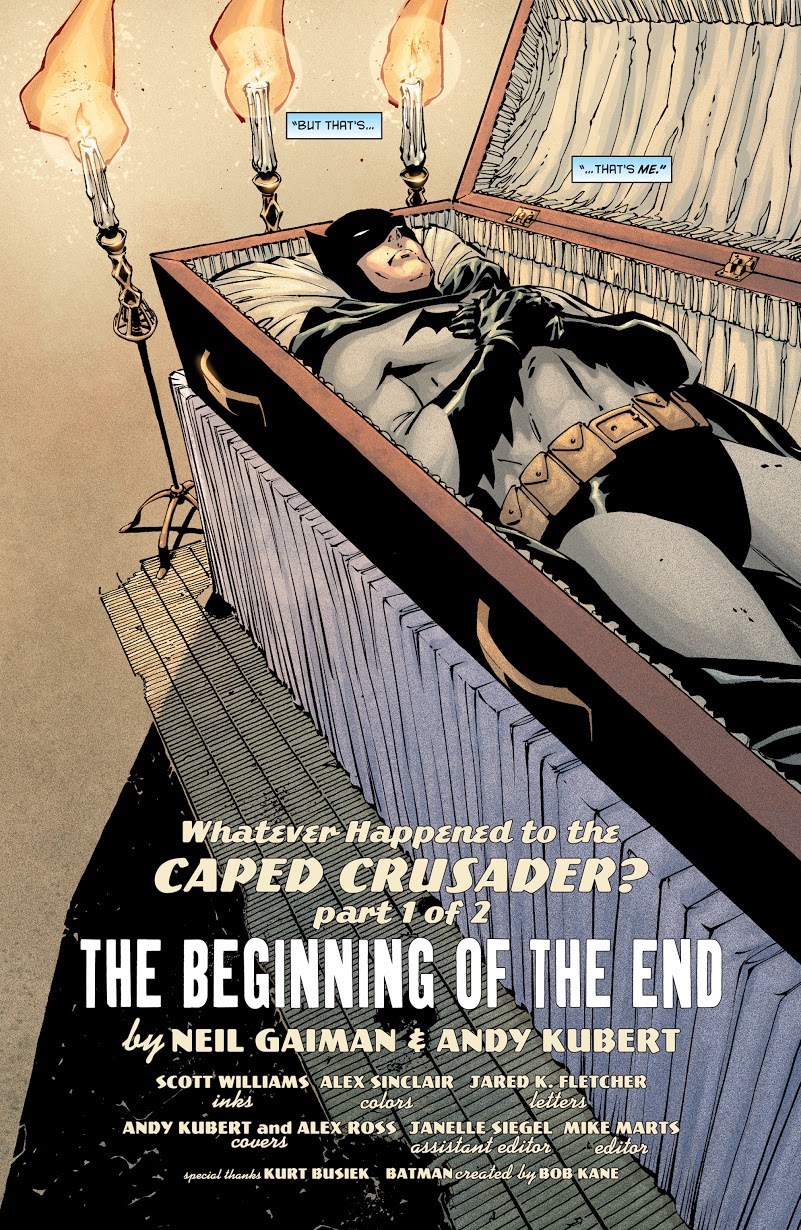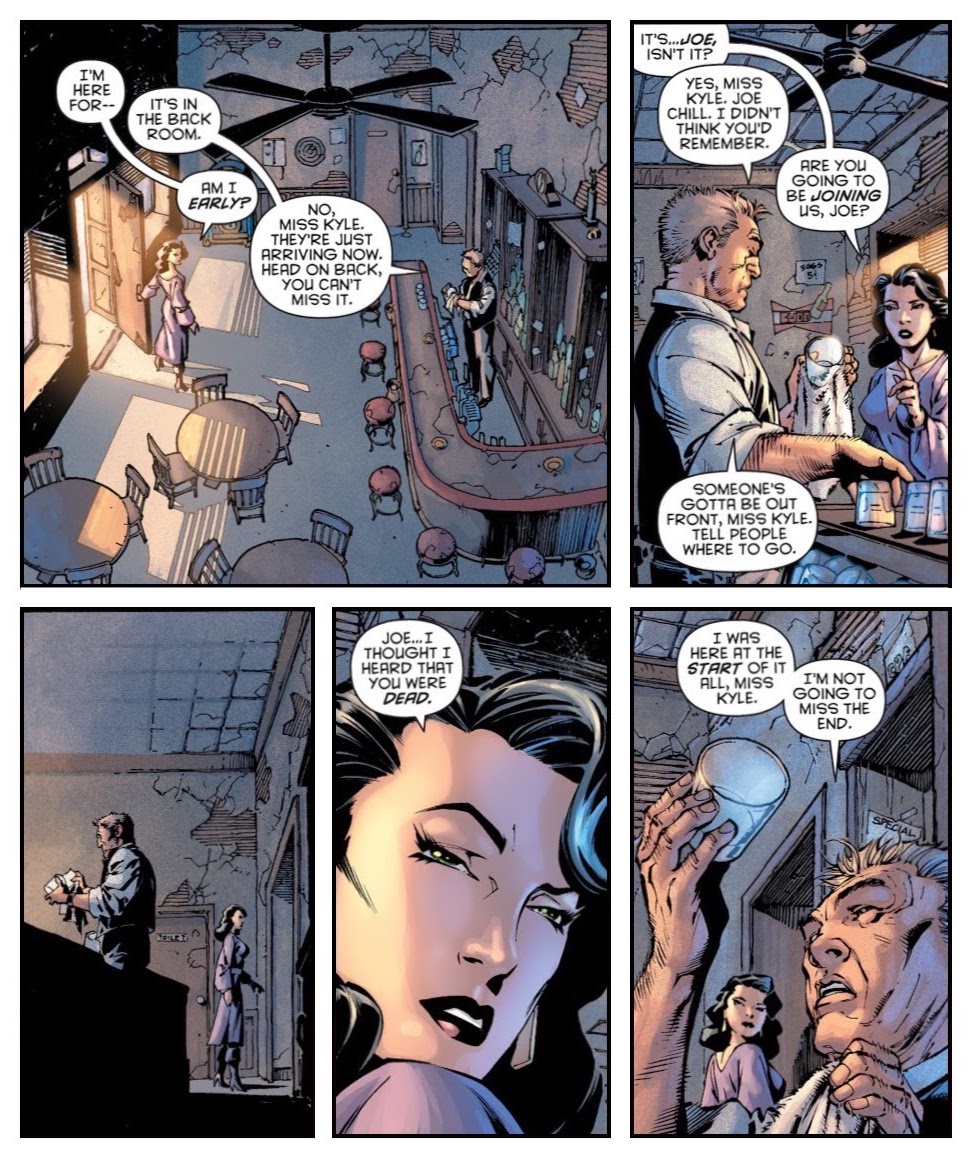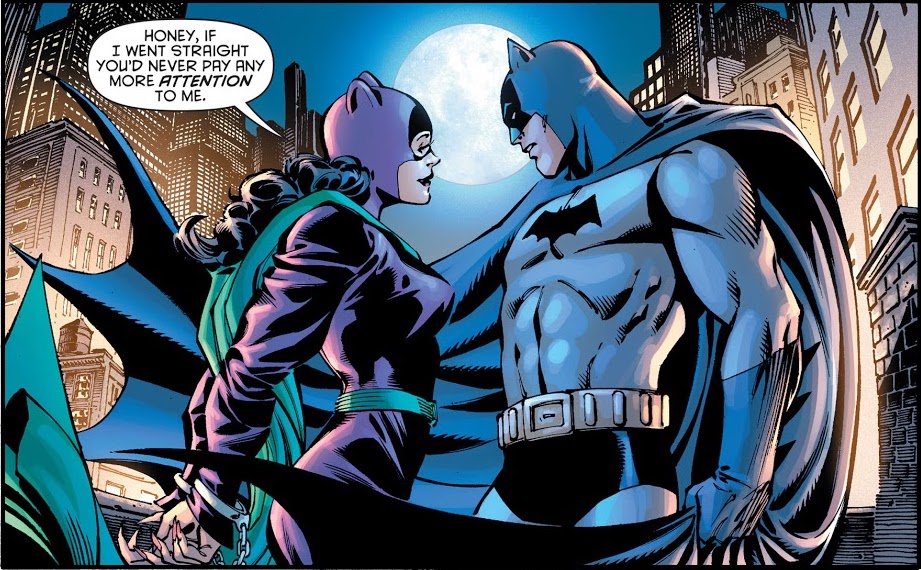I may have scared off most readers, understandably ignorant of and disinterested in
the intricacies of DC Universe continuity, with yesterday’s post on Batman’s status quo. Which I’m loathe to do when recommending accessible graphic novels to civilians — but I wanted to properly set the backdrop for my review of Neil Gaiman and friends’ Batman: Whatever Happened to the Caped Crusader?. Since I don’t really consider the tales contained therein accessible, though, I suppose it’s all good.

Cover to Batman: Whatever Happened to the Caped Crusader? The
Deluxe Edition © 2009 DC Comics. Pencils, Inks: Andy Kubert.
Colors: Alex Sinclair. Design/Typography: Unknown.
The book’s title story isn’t nearly as dependent on knowledge of recent comics as the likes of Final Crisis or Blackest Night, and in fact requires no familiarity with Grant Morrison’s ambitious tapestry of the past few years. I just don’t think the material reprinted in the collection, published by DC as a $14.99 trade paperback last month in the wake of a $24.99 hardcover last year, will be rewarding to newcomers to the Dark Knight mythos. “Whatever Happened to…” itself depends on not merely affection for the character and recognition of his various, often contradictory interpretations since 1939, but ideally affection for his having various, often contradictory interpretations over that span, while the older entries that round out the volume (some of Gaiman’s earliest American work) push different yet similar buttons.
A far more satisfying first taste of modern Batman comics, to me, is 1987’s Batman: Year One, written by Frank Miller and illustrated by David Mazzucchelli & Richmond Lewis, re-released a few years back in a gorgeous new edition for its 20th anniversary. The softcover is still in print and very worth a visit to your local comics shop. You can get Whatever Happened to the Caped Crusader? while you’re there, and I wouldn’t not recommend it to more-Batman-aware readers with a soft spot for milestones or metafiction; I simply wish it had been better.

Panels from Riddler story in Secret Origins Special #1 © 1989 DC Comics. Script: Neil Gaiman. Pencils, Letters: Bernie Mireault. Inks: Matt Wagner. Colors: Joe Matt. [enlarge]
Gaiman was asked to, in essence, deliver the eulogy to Batman RIP — not one that linked up with Morrison’s grand arc “in continuity” but one for the fans. Both authors were part of DC Comics’ late-’80s British Invasion, sparked by the success of Alan Moore; they made their bones Stateside reviving or revitalizing such features as, respectively, The Sandman and Doom Patrol. Morrison’s Animal Man was a brilliant, sometimes frustrating, ultimately quite touching piece of self-consciousness that broke the fourth wall, as his Doom Patrol broke taboos in telling adventure stories about a surrogate family of misfit superhumans. Sandman has enjoyed the most acclaim outside traditional American comics readership among that era’s like efforts, including Moore’s pivotal Swamp Thing, although I distinctly remember debating with one good friend the merits of Morrison vs. Gaiman: I found Gaiman the more consistently satisfying writer and Morrison’s work perhaps more ambitious but ultimately less satisfying narratively between his undeniably astounding spikes of genius. Their
output in the intervening decades hasn’t disabused me of that broad judgment.

First half of double-page splash from “Whatever Happened to the
Caped Crusader?” in Batman #686 © 2009 DC Comics. [enlarge]
Moore wrote the justifiably celebrated two-parter “Whatever Happened to the Man
of Tomorrow?” for the September 1986 issues of Superman and Action Comics, homaging decades of Superman lore that was being put in storage after Crisis on Infinite Earths. Unlike his cousin Supergirl or the contemporary Flash, Superman hadn’t even apparently died during that Crisis, as Batman did in early 2009; there was, however, a clean (or a rather jagged, actually) break between the pre- and post-Crisis continuities in 1986, whereas Final Crisis took place within ongoing continuity. Gaiman therefore chose to tell a tale set outside any particular DC Universe, paying respect to periods past in more metaphysical fashion than did its predecessor. That “Whatever Happened to the Caped Crusader?” links itself in name to Moore’s story
isn’t necessarily inappropriate, but they’re different animals.
Gaiman’s story opens with both scripted and visual clues that we’re not in Gotham anymore — or that we are ostensibly in Gotham, but a dreamlike Gotham closer to a melancholy Oz than to Kansas, even if the captioned dialogue indicates that we’re not exactly observing a dream. The dialogue, a two-person conversation in boxes of blue and gray, suggests that at least one of the speakers is Batman. Panel illustrations, meanwhile, show us a raven-haired beauty parking her Catmobile in front of a total dive, greeting bartender Joe Chill, and predictably being referred to in turn as Miss Kyle when the word balloons commence. Things only get stranger after the ever-stoic Alfred Pennyworth leads her towards an open casket which a double-page spread confirms is cradling the Dark Knight, as a blue caption protests, “... That’s me.” It’s then that the scope of this story’s surreality is made clear, with characters from multiple eras of Batman legend mingling — both a Joker modeled after the 1950s Dick Sprang version and one who stepped out of the 1990s animated series appear, for example, although Gaiman and penciler Andy Kubert are careful never to have alternate avatars of a given character interact. My favorite lines are in the small talk, full of winks that generally avoid the precious, as when Alfred tells Kirk Langstrom at the service that he may sit
on “either side of the aisle.”

Panels from “Whatever Happened to the Caped Crusader?” with Selina
Kyle and Joe Chill © 2009 DC Comics. Credits as below. [enlarge]
Surreality is an especially apt description since the tale essentially takes place on a plane above the standard comics reality that it supplanted for a month when it first ran in April 2009’s Batman #686 and Detective Comics #853 (edited by Mike Marts with Janelle Siegel). The reader becomes witness, along with Batman and his mysterious companion, to a series of testimonials from the Dark Knight’s friends and foes as to what kind of man he was and how he died. First comes Selina Kyle’s, and it references her 1940 debut as The Cat (later The Cat-Woman, then Catwoman) in Batman #1 as well as 1983’s classic “The Autobiography of Bruce Wayne” from The Brave and the Bold #197 (featuring the Earth-Two incarnations of the star-crossed couple) before veering into Elseworlds territory and a disturbing finish. Considerably more disturbing to me is Alfred’s account of Bruce Wayne’s life and death, however; even if it’s supposed to be an absurdist commentary on interpreting Batman as insane or an indictment of portraying him too realistically, it’s too much of that topic to be remotely enjoyable.

The Batman/Catwoman panel referred to in the paragraph below, from “Whatever Happened
to the Caped Crusader?” © 2009 DC Comics. Script: Neil Gaiman. Pencils: Andy Kubert.
Inks: Scott Williams. Colors: Alex Sinclair. Letters: Jared K. Fletcher. [enlarge]
Kubert and inker Scott Williams shift styles to reflect the moods and if applicable the times or even specific stories invoked, echoing Sprang, creator Bob Kane, Neal Adams, Brian Bolland, David Mazzucchelli, and more. It’s unfortunate that I prefer Kubert’s tributes to his own style; his layouts are accomplished, but I’ve never really warmed to his rendering. I would have enjoyed the story much more if the baseline art were in the bolder, simpler vein of his references to Year One’s Mazzucchelli and “Autobiography” artist Joe Staton — both of whose work, somewhat curiously although with no complaints from me, are largely used as stand-ins for Kane, Jerry Robinson, and Sprang in the Catwoman vignette; I could swear that in one shot Kubert et al. are homaging Dave Gibbons doing a gloss on the Carmine Infantino & Murphy Anderson look as swiped from a Staton panel. Alex Sinclair’s colors, meanwhile, are overwrought in the fashion typical of the past dozen-plus years, working against the attempted evocation of period and against the clarity of the art in general.
The ending to “Whatever Happened to the Caped Crusader?” has struck readers as variously trite and profound, not unlike the recent conclusion to a certain long-running network television show. One huge difference between the two endings, of course, is that both Gaiman and his readers knew that his tale was taking place off to the side, at once timeless and fleeting, as the Batman saga (or sagas) blasted full steam ahead in the mainstream DC Universe, a feature-film franchise, a Saturday-morning cartoon, and myriad other venues. I didn’t mind the ending in concept, but in execution it precariously straddled the line between showing us the child that still lived inside Bruce Wayne and infantilizing him; I was also distanced from the story at what should have been the height of its emotional impact by the reference to a particular well-known book by another name, presumably for legal reasons, when the title could have been sidestepped altogether with thoughtful dialogue. And the story would have benefitted from a higher page count. While a four-issue run on the order of the 1970s storyline collected last year in The Strange Deaths of Batman (in which various villains narrated their supposed murders of the hero) might have been seen as pandering, “Whatever Happened...” is already as much fan service as it is metatextual insight — neither unexpected nor an inherently bad thing. The middle and the ending deserved more room to breathe.

Panels from “Whatever Happened to the Caped Crusader?” with the original
Bat-Girl eulogizing Batman © 2009 DC Comics. Credits as above. [enlarge]
Coincidence or the author’s own proclivities, if not both, find the earlier Gaiman
stories likewise invoking different eras of Dark Knight lore while commenting on the storytelling process. Reprinted are “A Black and White World” from 1996’s Batman Black and White #2, illustrated by Simon Bisley; “Pavane” from 1988’s Secret Origins #36, drawn by Mark Buckingham and colored by Nansi Hoolahan; “Original Sins” from 1989’s Secret Origins Special #1, penciled by Mike Hoffman, inked by Kevin Nowlan, and colored by Tom McCraw; and “When Is a Door” from that same Special, penciled by Bernie Mireault, inked by Matt Wagner, and colored by Joe Matt. The source anthologies were overseen by top-flight editors (Mark Chiarello and Scott Peterson on Batman Black and White, Mark Waid on Secret Origins) whom Gaiman was as fortunate to have aboard as they were to have him.
Bisley’s maniacal art stands in hilarious contrast to the workaday conversation in
“A Black and White World”, which shows Batman and The Joker running lines in the green room before performing a scene for the comics. “Pavane” has Buckingham ape the Sheldon Moldoff & Joe Giella pairing for a brief flashback to Poison Ivy’s 1966 debut in Batman #188, also evoking various eras through Batman memorabilia, as Ivy toys with a federal agent visiting her cell. The more realistically drawn “Original Sins” was initially a framing sequence for three origins of Batman villains, one of which is this collection’s delightfully odd “When Is a Door”. “Sins” opens with the Dark Knight cautioning a visiting television crew against filming a documentary on Gotham City’s costumed criminals; in “When Is a Door” the crew interviews a rather mature Eddie Nigma, whom Gaiman and Mireault have outfitted in a three-piece suit and bowler hat like those worn during Frank Gorshin’s 1966-67 portrayal of The Riddler opposite Adam West, while Nigma scampers through a warehouse full of the giant props that were a trademark of Batman co-creator Bill Finger. Neither “Pavane” nor “When Is a Door” are strictly origins; Ivy and Riddler each only make the merest mention of their previously told backstories, calling into question both the validity of the tales and their own reliability as narrators in the process. Nigma reveals that the title of “When Is a Door” is not necessarily the start of a riddle but a statement unto itself.

Panels from Poison Ivy story in Secret Origins #36 © 1989 DC Comics. Script: Neil Gaiman.
Pencils, Inks: Mark Buckingham. Colors: Nansi Hoolahan. Letters: Augstin Mas. [enlarge]
The entirety of Batman: Whatever Happened to the Caped Crusader? is effectively
a set of stories in which stories are spun, whose content is often a matter of time and perspective, a favorite motif of Gaiman’s and of mine. And like the title story, the others supplement their observations of the human condition with choice dialogue. Batman asks for a copy of Newsweek while he waits for his call in “A Black and White World”, but it’s “company policy” to only keep Time on hand (DC Comics being a corporate cousin to the magazine). Poison Ivy asks slyly, in what would have been a surefire groaner if delivered as a punch line, “Who can keep up with their family tree these days?”. The Riddler caps his nostalgic walk through his past exploits with a ridiculously sublime anecdote, prompting interviewer Steve Jones to ask, “Is that true?”; Nigma replies, “Does it matter?”.
![♪ [insert 20th Century fanfare here] ♫ Batman in spectral form above queue of his friends and foes on a run-down side street with gothic cityscape rising behind, framed by searchlights](https://blogger.googleusercontent.com/img/b/R29vZ2xl/AVvXsEgxQnquVPZjcqjzbfhT_M4tJebisX_sboleGoFOWaRAlQpl0UdgTo5Owrfvsh2T8pFfVdOUxiG4YyT-HVcVO0ChY2KuK8sASdJW_MFmwOKvhhe7lTBoE9XAm2Rt-xHLW0DqpljiodqA2Fhh/s0/BatmanWHTTCC-Batman686CAlt-PinUp.jpg)
Cover to Batman #686 as reprinted sans copy in Whatever Happened
to the Caped Crusader? The Deluxe Edition © 2009 DC Comics.
Pencils, Inks: Andy Kubert. Colors: Alex Sinclair.
Filling out the omnibus are cover reproductions from the title story’s original issues, minus trade dress, and a sketchbook section of Andy Kubert’s prep. The standout among the covers is Alex Ross’ contribution to Batman #686. Kubert and Alex Sinclair’s other cover to that issue is solid, as well as more specific to the story, but the pair’s efforts on Detective Comics #853 again suffer from over-rendering (plus my personal Batman peeve, the dreaded blue-for-black cape). Kubert’s sketchbook, though, spotlights everything that I like about his work until the final stages of the penciled pages done in his usual style; the character designs adapting his style to earlier artists’ and a page from the Catwoman vignette reinforce my thoughts of what might have been.
[Note: All the stories in Batman: Whatever Happened to the Caped Crusader? are now available with several more in the newer anthology The DC Universe by Neil Gaiman.]
Images from DC Comics digital editions. Characters TM/® DC Comics.
Related: Gotham City 49 Cents • We Got a Live One Here • DK Delight •
Betty’s Here; Veronica, Too • If You Meta the Batman, Kill the Batman

Whoa. For a book you didn't particularly like, Blam, you sure had a lot say about it. ; )
ReplyDeleteI would almost swear that in one shot Kubert et al. are homaging Dave Gibbons doing a gloss on the Carmine Infantino & Murphy Anderson look as swiped from a Staton panel.
Am I crazy to see what you mean?
The ending to "Whatever Happened to the Caped Crusader?" has struck readers as variously trite and profound,
I think I geeked out to this story more than you did, but at the end, to quote Dorothy Parker, "Tonstant Weader fwowed up." Nice idea, maybe; poor execution.
Nigma reveals that the title of "When Is a Door" is not necessarily the start of a riddle but a statement unto itself.
I never noticed this before. You're absolutely right and it's fricking brilliant. How did I never notice this before?
Really looking forward to more comics stuff, especially if it's as insightful as this, and sorry for not having the time for the comments you deserve. Maybe soon.